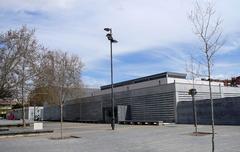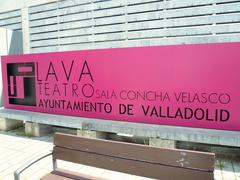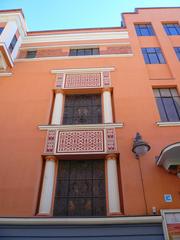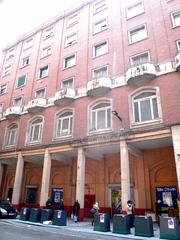Museo de Valladolid: Visiting Hours, Tickets, and Visitor Information
Date: 04/07/2025
Introduction: Exploring Valladolid’s Cultural Heart
The Museo de Valladolid, set in the magnificent 16th-century Palacio de Fabio Nelli, stands as a vital gateway to understanding the rich archaeological, artistic, and cultural heritage of Valladolid and the Castile and León region. Established in 1879 and permanently housed in the Renaissance palace since the 1960s, the museum offers an immersive experience, guiding visitors through millennia of regional history. Its collections span from prehistoric artifacts to Roman mosaics, medieval relics, fine arts, and ethnographic treasures, all thoughtfully displayed within a historic architectural masterpiece (Wikipedia: Palacio de Fabio Nelli; WhichMuseum; Spain This Way).
The museum’s location in Valladolid’s city center, alongside other significant sites like Plaza Mayor, Casa de Cervantes, and the National Museum of Sculpture, makes it an essential stop for anyone seeking to explore the city’s layered past. This guide provides detailed information on visiting hours, ticketing, highlights of the collections, accessibility, and practical tips to ensure a rewarding and well-prepared visit (Turismo Castilla y León; Spain.info; Museo de Valladolid Official Website).
Table of Contents
- Historical Background and Architectural Significance
- Collections and Exhibitions
- Visitor Information
- Travel Tips and Nearby Attractions
- Frequently Asked Questions (FAQ)
- Conclusion and Call to Action
- References and External Links
Historical Background and Architectural Significance
Evolution of the Museo de Valladolid
Founded in 1879 as the Provincial Museum of Antiquities, the Museo de Valladolid’s mission has been to preserve and showcase the region’s archaeological and artistic legacy. Originally housed in the School of Santa Cruz, it relocated in the 1960s to the Palacio de Fabio Nelli, a Renaissance gem commissioned by Genoese banker Fabio Nelli and completed in the early 17th century (Wikipedia: Palacio de Fabio Nelli; WhichMuseum).
Palacio de Fabio Nelli: Renaissance Masterpiece
The Palacio de Fabio Nelli is celebrated for its symmetrical façade, classical proportions, arcaded courtyards, and grand staircase—archetypes of Renaissance elegance and harmony. Designated a Bien de Interés Cultural in 1961, the palace’s adaptive reuse as a museum ensures both its preservation and continued relevance (Wikipedia: Palacio de Fabio Nelli).
Collections and Exhibitions
Archaeology
The museum’s archaeological collection spans ten rooms, presenting a chronological journey from the Paleolithic era through Romanization and the Middle Ages. Notable artifacts include:
- Prehistoric tools and ceramics from Soto de Medinilla and Padilla de Duero.
- Roman mosaics, coins, and funerary stelae that illustrate local Romanization.
- Visigothic jewelry and medieval relics, reflecting evolving cultures and traditions (WhichMuseum; Turismo Castilla y León).
Fine Arts
Eight rooms are dedicated to Valladolid’s artistic tradition, including:
- Religious paintings and altarpieces from the 15th–16th centuries.
- Polychrome wood sculptures by Castilian masters such as Juan de Juni and Gregorio Fernández.
- Flemish tapestries, ceramics, and goldsmithing that highlight the region’s decorative arts (Spain This Way).
Ethnography and City History
A section of the museum traces urban and social development through:
- Traditional costumes, agricultural tools, and household objects from the 18th to 20th centuries.
- Historical documents, maps, and photographs showcasing Valladolid’s growth as a cultural and political center.
Temporary Exhibitions
Rotating exhibitions address themes such as the Romanization of the Duero Valley, Castilian religious art, and artisanal traditions. Collaborative projects with national and international institutions further enrich the museum’s cultural offerings (Museo de Valladolid Official Website).
Visitor Information
Visiting Hours and Tickets
As of July 2025, the museum’s official opening hours are:
- Tuesday to Saturday: 10:00 to 14:00 and 17:00 to 20:00
- Sundays and Public Holidays: 10:00 to 14:00
- Closed on Mondays
Always confirm current hours on the official museum website, as times may change for holidays or special events.
Ticket Pricing:
- General Admission: €1.50
- Combined Ticket: €5.00 (valid for Museo de Valladolid and Museo Nacional de Escultura, usable over five days)
- Free Entry: Sundays
- Discounts: Available for students, seniors, and groups
- Guided Tours: Free, inquire onsite for schedules (Turismo Castilla y León)
Tickets are sold onsite only; online booking is currently unavailable.
Guided Tours and Accessibility
- Guided Tours: Available in Spanish, and occasionally in English. Reservations can be made onsite or by phone.
- Accessibility: The museum is wheelchair accessible with ramps and elevators, though some historic areas have uneven floors. Service animals are welcome, and staff assistance is available for visitors with mobility concerns.
- Languages: Most labels are in Spanish, with English on key exhibits. English brochures may be requested; translation apps are recommended for non-Spanish speakers.
Museum Facilities and Etiquette
- Facilities: Restrooms, cloakroom, and a gift shop are available. There is no café onsite, but numerous dining options are nearby (Turispanish Guide).
- Photography: Allowed in most areas (no flash or tripods). Restrictions may apply during temporary exhibitions—check signage or ask staff.
- Etiquette: Maintain silence, set phones to silent, and avoid food or drink in exhibition areas.
Travel Tips and Nearby Attractions
- Location: Plaza de Fabio Nelli, s/n, 47003 Valladolid, Spain. Accessible on foot and by city bus; limited street parking available.
- Best Times to Visit: Spring and autumn offer pleasant weather and fewer crowds.
- Nearby Attractions: National Sculpture Museum, Casa de Cervantes, Patio Herreriano Museum of Contemporary Spanish Art, and Plaza Mayor are all within walking distance (Spain This Way; Lonely Planet Valladolid).
- Duration: Plan 1–2 hours to explore permanent and temporary exhibitions.
- Souvenirs: The shop offers art books and local crafts.
Frequently Asked Questions (FAQ)
Q: Where is the Museo de Valladolid located?
A: In the Palacio de Fabio Nelli, Plaza de Fabio Nelli, s/n, 47003 Valladolid, Spain.
Q: What are the Museo de Valladolid visiting hours?
A: Tuesday to Saturday, 10:00–14:00 and 17:00–20:00; Sundays and public holidays, 10:00–14:00; closed Mondays.
Q: How much are tickets?
A: General admission is €1.50; free on Sundays. Discounts and combined tickets are available.
Q: Can I purchase tickets online?
A: No, tickets are only available at the museum entrance.
Q: Are guided tours available in English?
A: Occasionally; check onsite or call in advance for schedules.
Q: Is the museum wheelchair accessible?
A: Yes, with elevators and ramps, though some historic areas may have uneven floors.
Q: Is photography allowed?
A: Yes, without flash or tripod, except where otherwise indicated.
Conclusion and Call to Action
The Museo de Valladolid is a must-visit for anyone interested in the rich tapestry of Spanish history, art, and culture. Housed in a breathtaking Renaissance palace, the museum provides a unique perspective on Valladolid’s evolution from its prehistoric roots through its artistic and political milestones. With affordable admission, accessible facilities, and engaging exhibitions, it is an essential stop for travelers, families, and scholars alike.
For the latest updates on visiting hours, tickets, and events, consult the official museum website. Enhance your visit with the Audiala app for personalized tours and cultural insights. Stay connected through social media and explore related articles to deepen your appreciation of Valladolid’s historical sites.




